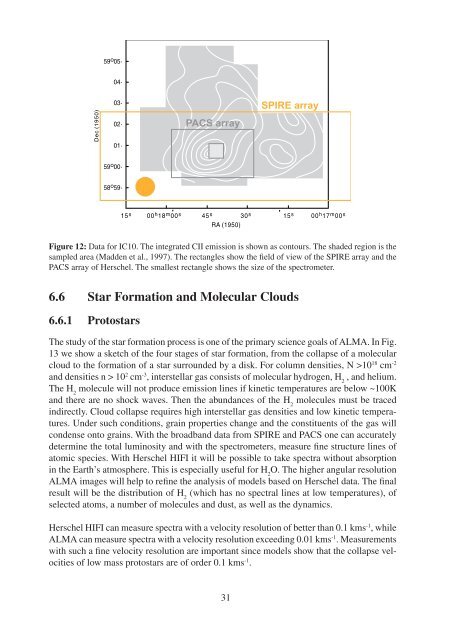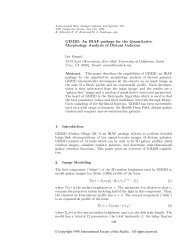4 Comparison of the ALMA and Herschel - ESO
4 Comparison of the ALMA and Herschel - ESO
4 Comparison of the ALMA and Herschel - ESO
You also want an ePaper? Increase the reach of your titles
YUMPU automatically turns print PDFs into web optimized ePapers that Google loves.
Figure 12: Data for IC10. The integrated CII emission is shown as contours. The shaded region is <strong>the</strong><br />
sampled area (Madden et al., 1997). The rectangles show <strong>the</strong> field <strong>of</strong> view <strong>of</strong> <strong>the</strong> SPIRE array <strong>and</strong> <strong>the</strong><br />
PACS array <strong>of</strong> <strong>Herschel</strong>. The smallest rectangle shows <strong>the</strong> size <strong>of</strong> <strong>the</strong> spectrometer.<br />
6.6 Star Formation <strong>and</strong> Molecular Clouds<br />
6.6.1 Protostars<br />
The study <strong>of</strong> <strong>the</strong> star formation process is one <strong>of</strong> <strong>the</strong> primary science goals <strong>of</strong> <strong>ALMA</strong>. In Fig.<br />
13 we show a sketch <strong>of</strong> <strong>the</strong> four stages <strong>of</strong> star formation, from <strong>the</strong> collapse <strong>of</strong> a molecular<br />
cloud to <strong>the</strong> formation <strong>of</strong> a star surrounded by a disk. For column densities, N >10 18 cm -2<br />
<strong>and</strong> densities n > 10 2 cm -3 , interstellar gas consists <strong>of</strong> molecular hydrogen, H 2<br />
, <strong>and</strong> helium.<br />
The H 2<br />
molecule will not produce emission lines if kinetic temperatures are below ~100K<br />
<strong>and</strong> <strong>the</strong>re are no shock waves. Then <strong>the</strong> abundances <strong>of</strong> <strong>the</strong> H 2<br />
molecules must be traced<br />
indirectly. Cloud collapse requires high interstellar gas densities <strong>and</strong> low kinetic temperatures.<br />
Under such conditions, grain properties change <strong>and</strong> <strong>the</strong> constituents <strong>of</strong> <strong>the</strong> gas will<br />
condense onto grains. With <strong>the</strong> broadb<strong>and</strong> data from SPIRE <strong>and</strong> PACS one can accurately<br />
determine <strong>the</strong> total luminosity <strong>and</strong> with <strong>the</strong> spectrometers, measure fine structure lines <strong>of</strong><br />
atomic species. With <strong>Herschel</strong> HIFI it will be possible to take spectra without absorption<br />
in <strong>the</strong> Earth’s atmosphere. This is especially useful for H 2<br />
O. The higher angular resolution<br />
<strong>ALMA</strong> images will help to refine <strong>the</strong> analysis <strong>of</strong> models based on <strong>Herschel</strong> data. The final<br />
result will be <strong>the</strong> distribution <strong>of</strong> H 2<br />
(which has no spectral lines at low temperatures), <strong>of</strong><br />
selected atoms, a number <strong>of</strong> molecules <strong>and</strong> dust, as well as <strong>the</strong> dynamics.<br />
<strong>Herschel</strong> HIFI can measure spectra with a velocity resolution <strong>of</strong> better than 0.1 kms -1 , while<br />
<strong>ALMA</strong> can measure spectra with a velocity resolution exceeding 0.01 kms -1 . Measurements<br />
with such a fine velocity resolution are important since models show that <strong>the</strong> collapse velocities<br />
<strong>of</strong> low mass protostars are <strong>of</strong> order 0.1 kms -1 .<br />
31




